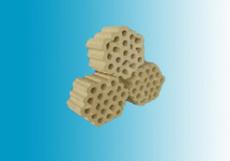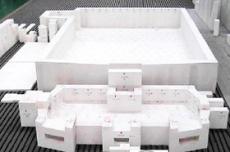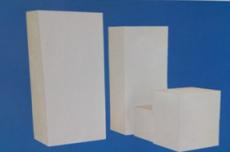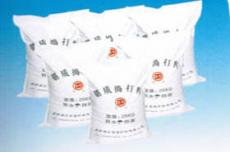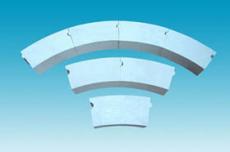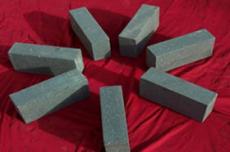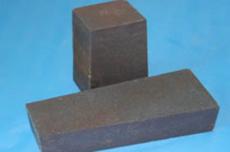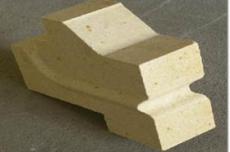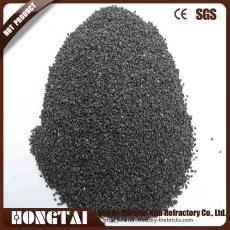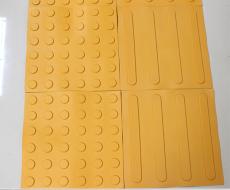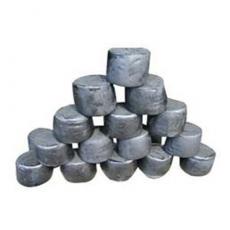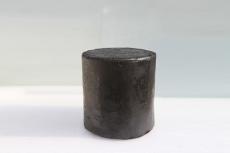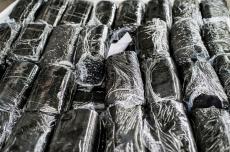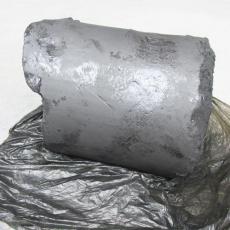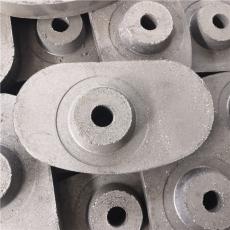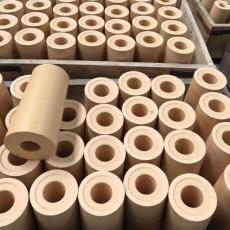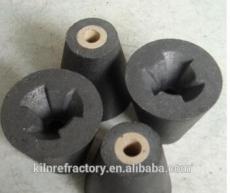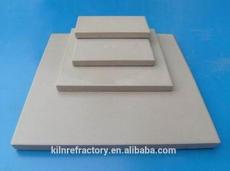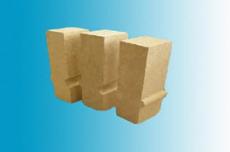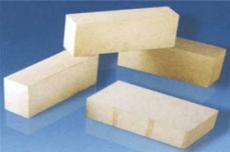
About the structural design of the flow hole
The flow hole is an important part of the glass furnace. When the melted, clarified and homogenized glass liquid passes through it and enters the distribution channel and the supply channel, it needs to be further homogenized and cooled, and finally enters the molding equipment for production and molding. Every day, 360~400t of glass liquid passes through this narrow channel, and the erosion and wear of the glass liquid on it are relatively large; and the working environment of the flow hole is poor, and the surrounding temperature is high. Once there is a problem, it cannot be replaced. Therefore, the flow hole uses electric melting AZS41# bricks or sawn bricks with good corrosion resistance. The fused AZS brick has an upward etch hole performance at the interface of solid phase, liquid phase and gas phase. The fused AZS brick is solid phase, the glass liquid is liquid phase, and the bubbles remaining in the glass liquid are gas phase. The erosion of the flow hole cover brick is greater than that of other places. In 5 to 6 years, the thickness of 300 to 400 mm is eroded upward. After the flow hole cover brick is eroded by 300 to 400 mm, the depth of the glass liquid is shallower, which is equivalent to the original kiln pool depth reduced by 300 to 400 mm. The discharge of the kiln is definitely affected. In order to meet the discharge, the furnace temperature can only be increased, and the energy consumption must be increased. After a few years, the furnace cover and other furnace bodies are burned, the furnace body becomes thinner, the internal temperature increases, and the heat dissipation of the furnace body is further increased.
In summary, the structure of the flow hole will affect the life of the kiln, the discharge and energy consumption. In view of the mechanism of corrosion of the flow hole cover brick, we designed the contact surface between the flow hole cover brick and the glass liquid to be inclined, so that the bubbles in the glass liquid are not easy to adhere to the flow hole cover brick, thereby greatly slowing down the corrosion of the flow hole cover brick and extending the life of the flow hole, that is, extending the life of the kiln.
About the pool bottom structure
The kiln pool bottom structure is also easy to affect the life of the kiln, especially the high white material or crystal white material kiln, because of its good heat permeability, the pool bottom temperature is high, and some metal objects will inevitably be brought into the batch material, and the metal objects will corrode the fused AZS more severely (downward corrosion holes). Once the fused AZS brick is corroded, the glass liquid will penetrate under the bottom plate brick, and "upward corrosion holes" will be generated, forming erosion like stalactites, and the bottom plate AZS brick will be corroded quickly, which will cause great harm to the safety of the entire pool bottom, affecting the life of the kiln, and in severe cases, the pool bottom leakage accident will occur.
To prevent such incidents from happening, one is to strictly control the entry of metal objects in the batch material, and the other is to strengthen the setting of the anti-leakage structure of the pool bottom. The pool bottom structure designed this time is a multi-layer composite structure.
Melting pool length and width
Once the melting rate is determined, the melting area of the kiln is determined. We determine the melting area of the kiln to be 152. When designing the length and width of the melting pool, we adhere to the design concept: when considering the coverage of the flame, not only the width of the flame is considered, but also the length of the flame. When designing, we refer to the principle of float glass kilns, that is, to distinguish the five stages of glass melting (1. silicate reaction, 2. glass formation, 3. glass homogenization, 4. glass clarification, 5. glass cooling). These five melting stages are carried out in different spaces and at the same time. Therefore, we believe that the design of the horseshoe flame kiln, as long as the length that the flame can reach, choose a larger length-to-width ratio, so that the clarification and homogenization of the glass liquid have a certain area. That is, when the flame can reach, the absolute length of the kiln should be large.
In order to reduce dead angles and facilitate the flow of glass liquid, we designed the front pool wall bricks of the melting pool into an eight-shaped shape.
Depth of melting pool
At present, the melting pools of more advanced kilns are divided into shallow pools and deep pools. In order to strengthen hot spots and improve the quality and output of glass, kiln sills are generally set. We design the area in front of the kiln sill as a shallow pool and the area behind the kiln sill as a deep pool. The area in front of the kiln sill is the melting zone (also known as the initial melting zone). The surface of the glass liquid in the melting zone is covered with thick batch materials and foam formed during the melting and decomposition of the batch materials. They are poor conductors of heat and a layer of insulation. Since the insulation layer affects the penetration and transfer of heat, the depth of the shallow pool should not be too deep. If it is too deep, a thick stationary layer or slow-moving layer will be formed at the bottom of the pool. The thickness of these stationary layers or slow-moving layers will change with the change of the bottom temperature of the pool or the change of the discharge amount, thereby adding to the natural convection of the glass liquid, thereby affecting the quality of the glass liquid; and after the glass liquid in these stationary layers or slow-moving layers is added to the natural convection of the glass liquid, it will cause repeated heating of the glass liquid and increase energy consumption.
Behind the kiln sill is the clarification and homogenization zone, also known as the fine melting zone (deep clarification tank for short). We should deepen the pool in this area. The deep clarification tank has a very obvious effect on improving the quality and output of glass kilns and reducing energy consumption. First, it increases the volume of the glass kiln and prolongs the residence time of the glass liquid in the furnace; second, "the clarification process of glass refers to the process of removing visible bubbles. From a formal point of view, this process is a simple fluid mechanics process, but in fact it is a complex physical and chemical process." The clarification speed of glass liquid is related to the viscosity of glass liquid, and the viscosity (including surface tension) is related to the temperature of glass liquid. If the depth of the deep clarification tank is too deep, although the bubbles are subjected to a large static pressure of glass liquid, the viscosity of glass liquid is high due to the low temperature of glass liquid, and it is difficult to discharge bubbles. According to computer simulation technology, the temperature of the bottom glass liquid in the deep clarification tank should be considered as no less than 1300℃. Therefore, the depth of the deep clarification tank of this kiln is designed to be 2200mm. When designing and calculating the depth of the deep clarification part of the melting tank, not only the heat permeability of the glass should be considered, but also the size of the kiln. For the same type of glass, the large kiln can be appropriately deeper.
Structure of the charging pool
The distribution of the batch material in the melting pool plays a very important role in the melting speed of the batch material. The wider the feeding port, the wider the feeder should be. Under the same feeding amount, the thinner the thickness, the wider the material city formed, the higher the heat utilization rate, and the faster the batch material melts. Because the discharge volume of this kiln is large, although unilateral feeding can reduce the loss of radiant heat and high-temperature airflow, considering that the feeder and other batch material conveying systems will wear out during long-term operation, it is inevitable that there will be failures, which will have certain difficulties in ensuring normal feeding and discharging. Therefore, a symmetrical bilateral charging pool structure should be adopted. The concept we adhere to when designing the charging pool is: lengthen the charging pool, which allows the batch to undergo a relatively sufficient silicate reaction in the pre-melting pool. The surface of the batch entering the furnace has begun to undergo a silicate reaction and has become sticky. The airflow of the flame is not easy to blow up the fine powder on the surface of the batch, reducing the blockage of the regenerator grid. Reduce dust flying, thereby reducing the erosion of the furnace body and extending the life of the kiln.
The shape of the charging pool should be determined by the type of feeder. Domestic and foreign practices have proved that the feeding effect and energy-saving effect of the swing-wrapped feeder are currently the best, and can save about 5% of energy. The energy-saving principle of the swing-wrapped feeder is as follows:
(1) The batch added to the furnace by the general feeder floats on the surface of the glass liquid. Because the batch is loose, its thermal conductivity is very low and the melting speed is slow. The enveloping feeder is used to squeeze the batch material into the glass liquid. During this process, the high-temperature glass liquid is squeezed up to fill the pores in the batch material, thereby increasing the thermal conductivity of the batch material. If the feeder is installed and adjusted well, the batch material is partially wrapped in the glass liquid like a dough, thereby greatly accelerating the melting speed, increasing the amount of material discharged when melting quickly, and thus reducing energy consumption.
(2) The swinging enveloping feeder can swing the feed material in three directions: left, middle, and right. The number of times of pushing the material in the three directions can be set and adjusted arbitrarily, so that the material pile is very evenly distributed in the melting pool, and the melting pool area can be fully utilized. It effectively utilizes the radiation energy of the flame space, improves the utilization rate of the melting pool, and thus further accelerates the melting speed.
(3) Since the feed material is fed in three directions separately, the batch material is surrounded by glass liquid in small piles in the furnace, which increases the contact area with the glass liquid and realizes thin layer feeding.
(4) From another perspective, the swing-in feeder also has the advantage of extending the life of the kiln. Since the swing-in feeder regularly pushes the batch material in three directions, the batch material is evenly distributed at the rear end of the molten pool. The time it is in direct contact with the pool wall tiles is short, or even not in direct contact with the pool wall tiles, thereby extending the life of the pool wall tiles because the batch material has a much greater erosion effect on the pool wall tiles than the glass liquid.
